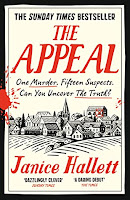Book Review: The Appeal by Janice Hallett
 |
My Rating:
3.5⭐
The Fairway Players is a local community theatre group based in a small English town. The group is gearing up for the performance of Arthur Miller’s All My Sons. The founders of the group are Martin Haywood and his wife, Helen who also own and operate The Grange Golf and Country Club. When their granddaughter Poppy is diagnosed with brain cancer, their oncologist suggests a steeply-priced experimental drug which has to be imported from America, the expense completely out of pocket with no insurance covering any part of the cost. Though the Haywards are assumed to be well to do, the sum of money required for the full course of treatment is exorbitant. They appeal to the community for assistance which leads to an all-out crowdfunding effort (A Cure For Poppy) with everyone doing their level best to bring in funds to contribute to the cause. As the story progresses we see doubt and suspicion directed towards the legitimacy of the appeal , the treatment options and the healthcare professionals involved and members of the “alpha” family. Secrets, groupism and rivalry plague the members of the theatre group which also leads to friction. Eventually one person ends up dead and one person is arrested for the crime.
There has been a murder. Someone is in prison for it. What was the motive? Is the person incarcerated truly guilty of the crime?
Janice Hallett’s The Appeal opens with Olufemi (Femi)Hassan and Charlotte Holroyd being tasked by their boss Roderick Tanner, QC, the senior partner at Tanner & Dewey, LLP, to thoroughly examine a dossier of correspondence between (most of) the characters associated with the case (emails and text messages), newspaper clippings and police reports in an attempt to analyze the events revolving around the group engaged in community theater and the fundraising campaign for a sick child. Initially, Tanner does not divulge much about the background of the case per se to gain a fresh perspective on the matter. Later he shares correspondence and other documents pertaining to the case based on which Femi and Charlotte chalk out and analyze probable scenarios that could have possibly led to the murder. The entire narrative is in epistolary format, told through the correspondence between the members of the theater group and those associated with them, the Haywoods and their oncologist, newspaper articles, police reports, and the messages and other correspondence exchanged between Femi, Charlotte and their boss.
I love cozy murder mysteries and with this novel, the reader can play detective and try to figure out what happened along with the two junior lawyers while they make their way through all the information provided. Though it wasn’t difficult to figure out who the culprit could be, some of the facts revealed in the process came as a surprise. Initially, it was fun to take notes and play armchair detective while reading the book but after a while, following the sequence of events and the characters became a tedious job. What didn’t work for me was the length of the novel, the repetitiveness and the inclusion of too many unnecessary characters and details (and the exclusion of some relevant information). Thankfully the material included two exhaustive lists of characters and a summary of events in the latter part of the book. The fact that the identity of the victim is mentioned after the halfway mark of a 400+ page novel should give you an idea of how the narrative drags in the middle. However, I did appreciate the epistolary format of the novel, the murder mystery at the core and the humor. In short, I liked the novel but wasn’t bowled over by it. Having said that I will be looking out for more of the author’s work in the future.
Comments
Post a Comment